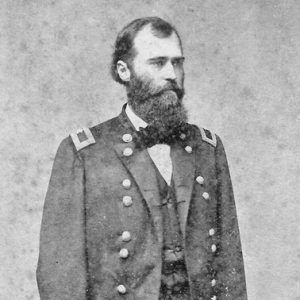calsfoundation@cals.org
Expedition from Little Rock to Mount Elba (January 22–February 4, 1865)
aka: Scout from Pine Bluff toward Camden and Monticello (January 26–31, 1865)
The January 22–February 4, 1865, expedition from Little Rock (Pulaski County) to Mount Elba (Cleveland County), which included two artillery batteries, three cavalry regiments, and six infantry regiments, was the last Union operation in the Civil War in Arkansas involving a relatively large number of combined-arms troops.
On January 22, 1865, a Union force of cavalry, infantry, and artillery left Little Rock for southwestern Arkansas to confront Confederates who one Iowan said were “attacking our pickets, making forays upon our baggage trains, and committing depredations generally.” Led by Brigadier General Eugene A. Carr, the expedition would pick up additional troops at Pine Bluff (Jefferson County) and would ultimately consist of the First Iowa, First Missouri, and Thirteenth Illinois Cavalry Regiments; the Forty-third, 106th, and 126th Illinois, Thirty-third Iowa, Twenty-eighth Wisconsin, and Fiftieth Indiana Infantry Regiments; and the Twenty-fifth Ohio Battery and Battery H, Second U.S. Colored Artillery Battery, along with soldiers attached to the pontoon train.
Carr and the cavalry regiments arrived in Pine Bluff on January 24, and he sent a force of 150 horsemen of the First Missouri Cavalry ahead to scout along the Saline River toward Jenkins’ Ferry. After consulting with Pine Bluff commander Brigadier General Powell Clayton, Carr proposed sending his cavalry toward Camden (Ouachita County), where Clayton conjectured “the enemy’s pickets can be driven into Camden and they can be induced to take up or destroy their bridge.” Not including artillerymen, Carr’s force would have 2,459 infantrymen and 1,060 cavalry troopers—a total of 3,519 men—backed by six artillery pieces as they headed south.
The cavalry left at daylight on January 26, with a horseman noting that “the cross road leading to Mt. Elba is very bad and our progress is slow.” They arrived at Mount Elba at noon the next day and found Carr’s advance patrol from the First Missouri Cavalry, which had run into and skirmished with a party of sixty or seventy Confederates. One man in the patrol was killed, and the patrol killed two Confederates and captured ten to fifteen others. After the infantry arrived, the pontoon bridge was laid across the Saline—Carr complained that the pontoon detachment’s leader “was slow in traveling and slow in laying the bridge”—and the cavalry crossed while the infantry camped at Mount Elba.
For the infantry, the period at Mount Elba was a welcome rest after the hard march from Little Rock. A Thirty-third Iowa soldier wrote that they sent out a foraging expedition, “which came back loaded with provisions. This part of the country having never before been occupied by Union troops, here was the more left for us; we lived off the fat of the land.”
The cavalry, meanwhile, passed through the 1864 Marks’ Mills battlefield on January 28, where they found that “the shallow graves had been opened by hogs and other animals, and the skulls and bones of the dead soldiers were exposed to view.” The troopers rode to within two miles of Camden, where a unit under Lieutenant Charles W. W. Dow of the First Iowa Cavalry encountered a Confederate force. One of the Iowans was wounded, while a rebel was killed and five others were captured, along with six horses.
They turned back the same day, camping that night at Chambersville (Calhoun County), and were back at Mount Elba on January 29.
Carr sent another scouting party “nearly to Monticello and toward Camden.” He concluded that the only Confederates in Monticello (Drew County) were a recruiting party, though there did appear to be a detachment guarding a bridge at Long View (Ashley County).
The expedition headed back toward Little Rock amid bad weather, with one infantryman observing that “it is not easy to march under twenty pounds of knapsack, and twenty or twenty-five pounds of other accoutrements, and even on good roads; and mud knee-deep has no tendency to help the matter.” They got back to the capital on February 4, 1865. Carr reported that the expedition “captured altogether 34 prisoners, being Confederates in arms and on furlough, and bushwhackers; 1 captain and 2 lieutenants.” Three Rebels were killed, while the Federals lost one killed and “2 soldier[s] and a guide wounded.”
The expedition from Little Rock to Mount Elba marked the last time the Union would mount a combined-arms operation involving thousands of soldiers. Even before returning to Little Rock, the Thirty-third Iowa, Twenty-eighth Wisconsin, and Fiftieth Indiana Infantry Regiments were ordered to leave Arkansas to participate in the Mobile, Alabama, campaign, and several other regiments were sent to other posts as troops in the state were sent elsewhere to bring down the faltering Confederate resistance east of the Mississippi River.
For additional information:
Blackburn, George M., ed. “Dear Carrie,…” The Civil War Letters of Thomas N. Stevens. Mount Pleasant, MI: The Clarke Historical Library, 1984.
Lothrop, Charles H. A History of the First Regiment Iowa Cavalry Veteran Volunteers, From Its Organization in 1861 to Its Muster Out of the United States Service in 1866. Lyons, IA: Beers & Eaton, 1890.
Urwin, Gregory J. W., and Cathy Kunzinger Urwin, eds. History of the 33d Iowa Infantry Volunteer Regiment 1863–6. Fayetteville: University of Arkansas Press, 1999.
The War of the Rebellion: A Compilation of the Official Records of the Union and Confederate Armies, Series I, Vol. 48, part 1, pp. 60–61, 64, 631, 650, 692. Washington DC: Government Printing Office, 1896.
Mark K. Christ
Central Arkansas Library System
 Civil War Timeline
Civil War Timeline Military
Military Eugene Asa Carr
Eugene Asa Carr 



Comments
No comments on this entry yet.